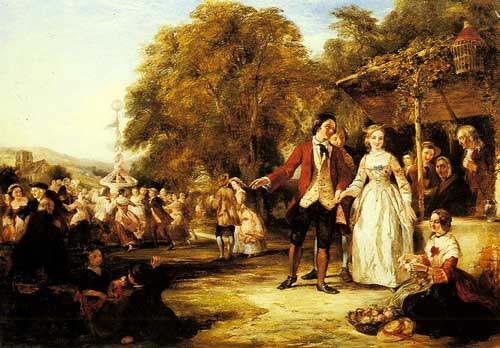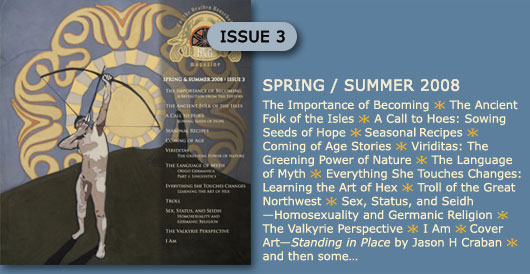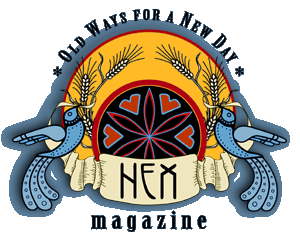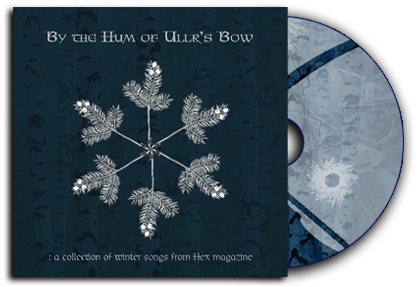~ THE TURNING OF THE WHEEL ~
May Day/Beltaine/Walpurgisnacht 2010
Issue #6 is Here!
Support Hex! This is a community-supported not-for-profit publication. You can
support us by clicking the image above and ordering magazines, CDs,
and prints, and by spreading the word to all like-minded folk!
* * * * * *
* Ghost Stories *
For Hex Issue 7 – Autumn/Winter 2010 – we’re celebrating the thin Yuletide
veil between the living and dead with tales of personal experiences
with ghosts, haunts, and spirits!
Share with us your most mysterious ghostly encounter!
Due date is 2010 Summer Solstice (June 21):
Submissions@hexmagazine.com
* * * * * *
 A May Day Celebration by William Powell Frith (1819-1909)
A May Day Celebration by William Powell Frith (1819-1909)
.: Carry on the Tradition :.
.: Have Some May Day Fun! :.
“The fair maid who, the first of May
Goes to the fields at break of day
And washes the dew from the hawthorn tree
Will ever after handsome be.”
– Mother Goose Nursery Rhyme [1]
May Day marks the half way point between Spring Equinox and Summer Solstice called Mid-Spring. A variety of traditions are associated with this time of year and many cultures acknowledge it’s passing in some way. Walpurgisnacht/Valborg was the German and Scandinavian celebration; the Dutch called it Whitsuntide; the Chinese celebrate Ching Ming; and the Celtic and Druid folk called their festival Beltane. It was a Goddess festival involving Aphrodite for the Greeks, Venus for the Romans, and Lada for the Slavic people. Some associate May Day with the Vanir Goddess Freya. For Heathens, Fires and May Pole Dancing are a large part of the traditions maintained today. Before the dancing could start in the old days one needed to start the May Eve Need-fires for warding off those pesky ill-willing wights and witches which were said to be hanging around at this time.
Many Heathen Mid-Spring traditions focused on May Eve. On this night the villages put their household fires out. Then at the right time fires were built from a natural source such as from the sparking of flint or the friction of wood, which is no easy task – just try it sometime! This is the Need-fire, and fire is certainly something any civilization needs. Examples of similar ideas abound in nearly all cultures if you dig deep enough. Here in the south the Native American Cherokee and Creek Nations were known to have doused the community fires and then kindled a new one that would then be shared out to the town. Heathens used May Eve fires to drive out any ill-will and mischief and purify the things people needed most: good livestock, good fields, good harvests, and good health.
Pairs of fires seemed to be the best way to make sure those things needing safekeeping, namely animals and people, could be fully cleansed. The animals would be driven through the center of the fires, while the people would leap the flames. Sometimes the animals and people were actually led through the burning fire with the thought that some good singing couldn’t hurt. It’s also been noted from many sources that nearly every hilltop had their own fires burning; perhaps this was a means of purifying larger areas such as fields and towns.
The May Eve fires were not allowed to go out, which could make for a restless night with many goings on, mostly unseen. Folks would stay up to watch over their homes and goods. Imagine having a crop in the field, milk and eggs coming into full production, and baby livestock arriving left and right! No one wanted any ill-will flying around.
In Sweden and perhaps elsewhere the flames would be watched to see which direction they pointed, north or south. If the flames pointed north it meant spring would be “cold and backward” but if the flames bent towards the south spring would be full of “mild and genial” weather. [2]
The next morning would be May Day. A portion of the need-fire would be distributed to all the households to start their own hearth fire. Such traditions helped to bond the community together with a common goal.
The May Pole dance further cemented that community bond. Most people probably needed a nap in the morning, but later in the day the May Pole would take center stage. Anyone who’s ever participated in a May Pole dance knows it’s far more complicated than it looks: one misstep and everyone is thrown off. However self-correction soon takes over and the dance goes on without missing a beat. This is a fine picture of community working at its best. People helping each other to achieve a particular goal that will be beneficial to all involved.
This year my local community is hosting another May Day Camp Out. It will be the third time the same May Pole is used. I purchased the ribbons for one of the past years and have just purchased those needed for this year. Ribbons can be costly, but diligent shopping and a few meditations later and I found 20 colorful rolls of 5 yard long cloth ribbon, 1-2 inches wide, for only $1.00 each!
The May Pole dance has become a part of what Heathenism is to me. I’ve been doing it for the past 7 years or so. If I can’t find any one putting on a May Pole Dance I host one myself. As I follow the ribbon to it’s completion I always think about my Grandmothers and the fun they must have had when they participated in such festivities.
Weaving a May Pole as a participant is an experience that can become a type of meditation. As the dance progress the energy of those involved begins to blur in the circle. When all goes right the meditation becomes a part of something bigger, something that can’t exist in isolation.
Several great ideas for May Pole dancing steps can be found on the Internet. This year at the May Day Camp-out we have several families with children who are going to have a practice session before hand. Not that we need any practice, one way or another that ribbon gets on that pole. But, it just might be a lot more fun and we’ll certainly be weaving a stronger bond of community.
Some of the important “finer” points to remember about the dance from past experiences are: make sure the ribbon is at least as long as the pole; make sure the ribbon is strong enough not to tear; make sure the ribbon is firmly attached at the top; make sure you have an even number of ribbons; and, make sure everyone knows what they are supposed to do.
So light your Need-fires and chase out the old to make room for the new, and dance it in with good friends and good fun. Have a great May Day!
The May-pole is up,
Now give me the cup;
I’ll drink to the garlands around it;
But first unto those
Whose hands did compose
The glory of flowers that crown’d it.
– Robert Herrick, “The Maypole”, 1660 [1]
[1] http://www.egreenway.com/months/monmay.htm#Quotes
[2] James Frazer, The Golden Bough
~ Hedgewife Teresa Luedke
* * * * * *

•MANNAZ•
Old English Rune Poem
Monn (Man) is, in his mirth, to his kinfolk dear;
Yet shall each disappoint the other,
Accordingly the Lord wills, by his law,
That the poor flesh be entrusted to the earth
Old Icelandic Rune Poem
Madhr (Man) is man’s pleasure
And mould’s increase
And a ship’s embellisher
Old Norse Rune Poem
Madhr (Man) is mould’s increase;
Great is the grip of the hawk
~ Rune poem translations by Sweyn Plowright
http://www.mackaos.com.au/Rune-Net/Primer/
There is something thrilling and audacious about the simple fact of being alive. Given the incredible odds against any one human being’s survival it is truly remarkable that we do. I myself was born in Caesarean section, and had the procedure not gone well would not have even made it to being a newborn. I’ve had a few other near-death experiences too, and indeed many of us have. We’re all literally lucky to be alive.
Yet the remarkable thing is that we forget. We forget what a gift it is to be living. It is shockingly easy to lose perspective on the gifts of Odin, Vili, and Ve, of life and form and consciousness. Shrouded in this amnesia one can live out all kinds of choices and life habits that with the benefit of distance seem foolish.
What are the ways in which we hurt the ones we love through our fear, anxiety, or anger? It is amazing that humans easily reserve our most churlish behaviour for those closest to us. Perhaps when people matter to one another a great deal they become the object of one another’s fears. Perhaps it is easy to lose perspective on the tacit compromises negotiated in the unfolding of daily life, compromises which at times produce little benefit for anyone.
What are the ways in which we compromise on our integrity, our dreams, or that little voice in the back of our head which unerringly wants to point us to the right path? In the face of the resistance that life imposes, the negative judgements of others and the inevitable set-backs of living, it is easily to incrementally drift away from the song that one’s heart desires to sing.
Rather than throw stones at folk who allow themselves to slip into such behaviour (and surely all stone throwing is from the doorstep of a glass house when it comes to reflecting on human nature), it seems more helpful to allow Mannaz to guide us into a different perspective. For although the rune poems suggest that our mortality is the source of disappointment, I would like to suggest that our deaths can also free us from our more destructive habits.
Near death experiences are a well known occasion for folk to radically change their lives, although not exactly the safest. Yet even by recalling Mannaz to our thoughts we can begin to scrutinise the daily decisions we make. At each moment Mannaz invites us to ponder: “is this really how I’d like to be thought of when I am gone? Is this really how I would like to use the finite time I have?” Such reflection can perhaps be revelatory, if not always so pleasant.
Yet naturally, change tends to provoke fear. Here again Mannaz comes to our rescue in the image of the “ship’s embellisher.” It takes incredible guts to be alive, a finite mortal being in a universe of infinite complexity. The only reason we do not notice our courage is – again – the amnesia of familiarity. Yet we can utilise our courage to make needed change, to lift out of the deep grooves that lull us into uncomfortable slumber. Mannaz can be called upon as a source of this life power.
It is a curious phenomenon that because we are so familiar with ourselves we all too easily lose sight and understanding of ourselves. Mannaz provokes us, dares us to be dissatisfied with acquiescence to the lower aspects of our nature. If the existentialist philosophers had a rune, Mannaz would be it.
Folk who have been reading these rune articles for a while may recall that April 30 is my birthday. This year, 2010, I turned 30. Add together “20” and “10” and you get – 30 again! The significance of all of this eludes me, yet I choose to regard it as having some kind of meaning, no matter that I cannot interpret it.
To me this is a little example of the mystery of our nature as human beings, the mystery which Mannaz seems to present. May Day is a moment for renewal and reconnection between the revealed world and the mysterious world, between our comprehension and our ignorance. None of us is likely to heed the challenge of Mannaz perfectly or for all time. But May Day heralds a perfect time to take stock, to take a fresh look at the aspects of our lives that have become habitual.
* * * * * *
By the Hum of Ullr’s Bow: Winter Songs Compilation CD is still available!
Bands on the compilation CD include:
• A Minority of One • Allerseelen • Andrew King • At the Head of the Woods • Beastianity • Hamramr • Irij • Ironwood • Ruhr Hunter • Sangre Cavallum • Sieben • Steve von Till • Svarrogh • Waldteufel • Wardruna
(You can read more about the artists here).
: Issue Three Almost Gone! :

Issues One, Two, Four, & Five are sold out!
Limited numbers of Hex Issue Three remain…
Order at:
* * * * * *
Until Summer Solstice, may you and your household be blessed and kept. Hail!
~ HEX Magazine
* * * * * *
We are currently looking for:
• submissions
• funding
If you are interested in applying or have any suggestions,
contact: info@hexmagazine.com
* * * * * *
Due date for Spring 2011 submissions
is Winternights/Samhain 2010
Support your community while exposing like-minded folk to your goods and services…
Advertisements must be relevant to HEX readers, and inclined toward a Heathen aesthetic. Prices listedare for completed AD files. If you need additional graphic design, we can help. Just contact us about our design fee.
AD space is now available in the newsletter for $10 a run.
Contact info@hexmagazine.com if you are interested.
>I< HEX >I<
> Please forward to all interested and relevant parties <












Leave a Reply